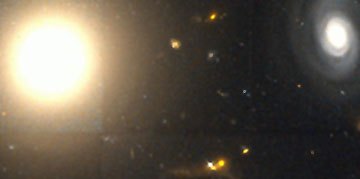Are elliptical galaxies influenced by a halo of dark matter? The theory has been accepted until recently through observation of the gravitational effects apparently caused by such matter. But 2003 findings (Romanowsky et al., Science 301, pp. 1696-1698) turned up little evidence for dark matter in such galaxies.
Now a different explanation for those observations has surfaced, one that seems to rescue the dark matter concept. That’s good news, because dark matter ought to be there. From a University of California at Santa Cruz press release:
“A dearth of dark matter in elliptical galaxies is especially puzzling in the context of the standard theory of galaxy formation, which assumes that ellipticals originate from mergers of disk galaxies,” added Avishai Dekel, professor of physics at the Hebrew University of Jerusalem and first author of the Nature paper. “Massive dark matter halos are clearly detected in disk galaxies, so where did they disappear to during the mergers?”
The dark matter effect has changed our view of galactic structure. Studies of the orbits of stars in spiral galaxies first revealed it — the rotational speed of stars on the outer edges of the galactic disk remained constant despite their distance from the core. What you would have expected, because most of the visible mass of such galaxies is concentrated in the central region, is that stars far from the center would move much more slowly.
 That led to the assumption of a dark matter halo that exerted its own influence on these outer stars. But elliptical galaxies pose a different challenge. They’re thought to result from the collision and merger of two spiral galaxies, and they appear as round, smooth shapes rather than rotating disks. The 2003 study found a decrease in velocity of planetary nebulae with increasing distance from the center of the galaxy, a finding inconsistent with dark matter theory.
That led to the assumption of a dark matter halo that exerted its own influence on these outer stars. But elliptical galaxies pose a different challenge. They’re thought to result from the collision and merger of two spiral galaxies, and they appear as round, smooth shapes rather than rotating disks. The 2003 study found a decrease in velocity of planetary nebulae with increasing distance from the center of the galaxy, a finding inconsistent with dark matter theory.
Image: A Hubble Space Telescope view of an elliptical galaxy, on the left, and a spiral galaxy to its right, both within the Coma Cluster. Similar dark matter haloes may be affecting the motion of stars within each. Credit: STScI/GSFC.
The new paper draws a different conclusion, noting that many of the stars studied are moving in elliptical orbits that mask their motion as seen from Earth. They may be moving quickly, in other words, but without as much motion along the line of sight. From the release:
To an observer outside the galaxy, a star on such an elongated orbit would only appear to be far from the galactic center if the long axis of its orbit is more or less perpendicular to the observer’s line of sight. If the long axis of the orbit is aligned with the line of sight, the star would always appear to be in the crowded center of the galaxy from the perspective of the observer.
Dark matter seems to be saved, at least in elliptical galaxies, and the earlier work proves even more useful. “”Our conclusion is that what they saw is exactly what the cold dark matter model would predict,” said Joel Primack, professor of physics at the University of California, Santa Cruz, and a coauthor of the Nature paper. “Their data are great, and this actually gives us more insight into how elliptical galaxies form.”
The paper is Dekel, Stoehr, Mamon et al., “Lost and found dark matter in elliptical galaxies,” Nature 437, 707-710 (29 September 2005), p.707.

